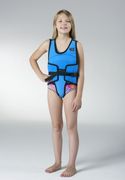Premium Aquatic Therapy & Fitness Gear for Wellness and Recovery
Discover Theraquatics' durable, high-quality aquatic therapy and fitness products designed to enhance rehab, training, and overall wellness. With decades of experience and a wellness-first approach, we provide tools, guidance, and support to help you maximize every water-based session - whether at home, in the clinic, or at the pool.WetVest II Child
Product Description
If you're serious about sports conditioning, cross training or water therapy, the WET VEST® II will match your commitment. For more than two decades, the WET VEST II has been the performance choice for serious athletes, rehabilitation patients, and fitness enthusiasts. Its patented design incorporates flotation panels sewn into a comfortable and snug fitting body vest. Like a wet suit, it provides a thermal layer that insulates your body in the water. Engineered to provide secure and balanced support, the WET VEST II fits much like a bathing suit, contouring to your body and allowing maximum freedom of movement. Newly updated with a secure buckle closure. Available in Blue, children’s sizes: XXX-Small, XX-Small and X-Small. Use our SIZE CHART to find your size.
*Measure from your shoulder to your inseam for accurate length.
Customer Comments: "I don't usually advocate strongly for a commercial item, but this flotation device is awesome. Its been the perfect item for my daughter to use for PT because it keeps her in a standing position in the water. But she is equally happy just using it for fun swimming in pools and the ocean. It isn't bulky, its comfortable and is fitted exactly to a tiny body because of the all-over velcro design. It comes in baby-size up through adult. I've just ordered our 3rd one only because it just plain wore out from use."
The WET VEST II has a special needs application for full body support in water, offering unrestricted movement and independence in the water for children with mild to moderate severity cerebral palsy.
“The WET VEST II holds the trunk firmly and provides improved proprioceptive awareness just where it is needed. It is not a life jacket and supervision is still needed, but most children quickly learn to move independently in the water. Children with Hemiplegia have asymmetric movement in the water, as there is less movement of the affected side. In most children with mild to moderate severity cerebral palsy, the leg will spontaneously start to move reciprocally with the unaffected leg within a relatively short time. If they have trouble keeping the leg down, put an old running shoe on the affected leg. Jogging in this manner, out of gravity, trains the child’s brain to produce a normal reciprocal movement. If they do not start using their affected arm, they will jog around in circles. In the mildly affected child, they quickly learn how to start using their arm more effectively. Novel, challenging tasks stimulate brain neuroplasticity.” Karen Pape MD
*Measure from your shoulder to your inseam for accurate length.
Customer Comments: "I don't usually advocate strongly for a commercial item, but this flotation device is awesome. Its been the perfect item for my daughter to use for PT because it keeps her in a standing position in the water. But she is equally happy just using it for fun swimming in pools and the ocean. It isn't bulky, its comfortable and is fitted exactly to a tiny body because of the all-over velcro design. It comes in baby-size up through adult. I've just ordered our 3rd one only because it just plain wore out from use."
The WET VEST II has a special needs application for full body support in water, offering unrestricted movement and independence in the water for children with mild to moderate severity cerebral palsy.
“The WET VEST II holds the trunk firmly and provides improved proprioceptive awareness just where it is needed. It is not a life jacket and supervision is still needed, but most children quickly learn to move independently in the water. Children with Hemiplegia have asymmetric movement in the water, as there is less movement of the affected side. In most children with mild to moderate severity cerebral palsy, the leg will spontaneously start to move reciprocally with the unaffected leg within a relatively short time. If they have trouble keeping the leg down, put an old running shoe on the affected leg. Jogging in this manner, out of gravity, trains the child’s brain to produce a normal reciprocal movement. If they do not start using their affected arm, they will jog around in circles. In the mildly affected child, they quickly learn how to start using their arm more effectively. Novel, challenging tasks stimulate brain neuroplasticity.” Karen Pape MD



